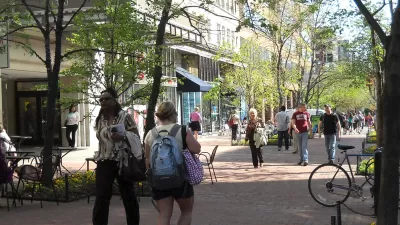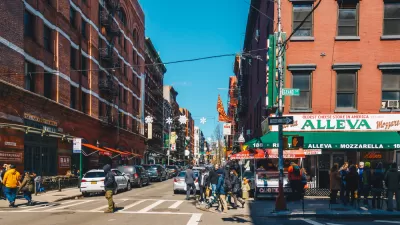Millennials and an aging Baby Boomer population have put a premium on "the hottest trend in real estate": walkability.

Via the Huffington Post, F. Kaid Benfield of PlaceMakers writes that the most sought after amenity for renters and buyers is now 'walkability'. Access to services, shops, restaurants and transportation is now a huge consideration for millennials and baby boomers, whether they prefer to live in the suburbs or in the urban core. Benfield cites a nationwide survey by the National Association of Realtors and Portland State University that found 'walkability' as an important factor in the selection of where people live.
Across all generations, the Realtors/Portland State survey found that an overwhelming majority of respondents - 79 percent - believe it to be very or somewhat important, in choosing a home, to be "within an easy walk of other places and things in the community." It also found that people who now live in such neighborhoods are especially satisfied with the quality of life in their communities. Fifty-four percent of those respondents who agreed with the statement "there are lots of places to walk nearby, such as shops, cafes, and restaurants" reported being very satisfied with the quality of life in their communities; only 41 percent of all respondents reported being very satisfied.
Benfield notes that while most cities across the United States have areas that can be considered 'walkable', there aren’t enough to meet demand.
And, because their supply is limited, prices for walkable locations are sky-high. Research has shown that each one-point increase in a home's Walk Score (a 100-point scale measuring an address's accessibility to walkable destinations) is associated with a $700 to $3000 increase in its value compared to less walkable homes of comparable size.
So what can be done to create more walkable areas in our cities and suburbs? Banfield offers a few good solutions, including the implementation of form-based codes and a focus on LEED for Neighborhood Development when updating that existing zoning codes.
FULL STORY: We Want More Walkable Neighborhoods -- but Can Our Communities Deliver?

Maui's Vacation Rental Debate Turns Ugly
Verbal attacks, misinformation campaigns and fistfights plague a high-stakes debate to convert thousands of vacation rentals into long-term housing.

Planetizen Federal Action Tracker
A weekly monitor of how Trump’s orders and actions are impacting planners and planning in America.

San Francisco Suspends Traffic Calming Amidst Record Deaths
Citing “a challenging fiscal landscape,” the city will cease the program on the heels of 42 traffic deaths, including 24 pedestrians.

Defunct Pittsburgh Power Plant to Become Residential Tower
A decommissioned steam heat plant will be redeveloped into almost 100 affordable housing units.

Trump Prompts Restructuring of Transportation Research Board in “Unprecedented Overreach”
The TRB has eliminated more than half of its committees including those focused on climate, equity, and cities.

Amtrak Rolls Out New Orleans to Alabama “Mardi Gras” Train
The new service will operate morning and evening departures between Mobile and New Orleans.
Urban Design for Planners 1: Software Tools
This six-course series explores essential urban design concepts using open source software and equips planners with the tools they need to participate fully in the urban design process.
Planning for Universal Design
Learn the tools for implementing Universal Design in planning regulations.
Heyer Gruel & Associates PA
JM Goldson LLC
Custer County Colorado
City of Camden Redevelopment Agency
City of Astoria
Transportation Research & Education Center (TREC) at Portland State University
Jefferson Parish Government
Camden Redevelopment Agency
City of Claremont



























